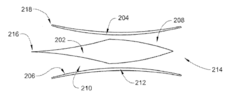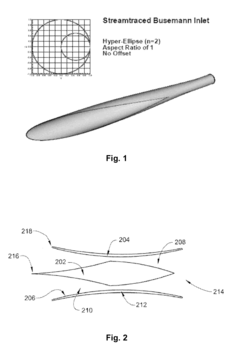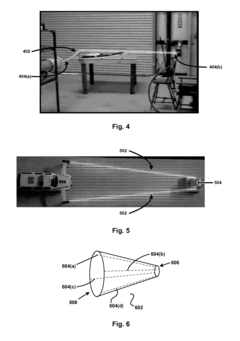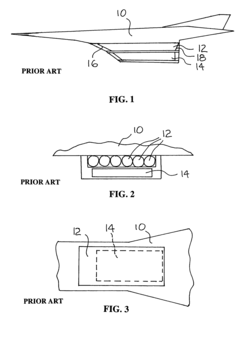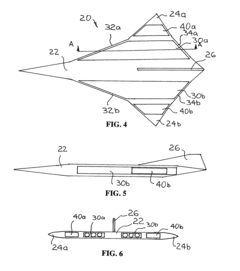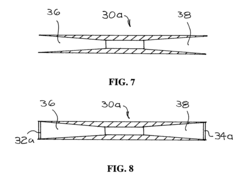Synergies Between Space Tourism and Scramjet-Powered Transport
AUG 13, 20259 MIN READ
Generate Your Research Report Instantly with AI Agent
Patsnap Eureka helps you evaluate technical feasibility & market potential.
Space Tourism and Scramjet Evolution
Space tourism and scramjet technology have evolved significantly over the past few decades, with both fields experiencing rapid advancements and growing interest from both the private and public sectors. Space tourism, once a distant dream, has become a tangible reality with the emergence of companies like Virgin Galactic, Blue Origin, and SpaceX. These pioneers have made substantial progress in developing reusable spacecraft and suborbital flight capabilities, paving the way for commercial space travel.
The concept of space tourism dates back to the 1960s, but it wasn't until the early 2000s that the first space tourist, Dennis Tito, embarked on a journey to the International Space Station. Since then, several wealthy individuals have followed suit, marking the beginning of a new era in space exploration. The industry has seen a shift from government-led initiatives to private sector involvement, with companies investing heavily in research and development to make space travel more accessible and affordable.
Parallel to the growth of space tourism, scramjet technology has undergone significant advancements. Scramjets, or supersonic combustion ramjets, are a type of jet engine designed for hypersonic flight. The development of scramjet technology can be traced back to the 1950s, but it wasn't until recent years that successful test flights have been conducted. Notable milestones include NASA's X-43A program, which achieved Mach 9.6 in 2004, and the successful flight of the Boeing X-51 Waverider in 2013.
The evolution of both space tourism and scramjet technology has been driven by advancements in materials science, propulsion systems, and aerodynamics. For space tourism, the focus has been on developing reliable, reusable spacecraft capable of withstanding the rigors of repeated launches and re-entries. Companies have invested in innovative heat shield materials, life support systems, and propulsion technologies to ensure the safety and comfort of space tourists.
Scramjet technology, on the other hand, has faced challenges in achieving stable combustion at hypersonic speeds and managing extreme temperatures. Research has centered on developing advanced materials capable of withstanding high temperatures, improving fuel injection systems, and optimizing engine design for sustained hypersonic flight. The potential applications of scramjet technology extend beyond space tourism, with implications for military applications and rapid global transportation.
As both fields continue to evolve, there is growing interest in exploring the synergies between space tourism and scramjet-powered transport. The integration of scramjet technology into space tourism vehicles could potentially revolutionize the industry, offering faster ascent and re-entry capabilities, reduced fuel consumption, and increased payload capacity. This convergence of technologies presents exciting possibilities for the future of space exploration and high-speed global transportation.
The concept of space tourism dates back to the 1960s, but it wasn't until the early 2000s that the first space tourist, Dennis Tito, embarked on a journey to the International Space Station. Since then, several wealthy individuals have followed suit, marking the beginning of a new era in space exploration. The industry has seen a shift from government-led initiatives to private sector involvement, with companies investing heavily in research and development to make space travel more accessible and affordable.
Parallel to the growth of space tourism, scramjet technology has undergone significant advancements. Scramjets, or supersonic combustion ramjets, are a type of jet engine designed for hypersonic flight. The development of scramjet technology can be traced back to the 1950s, but it wasn't until recent years that successful test flights have been conducted. Notable milestones include NASA's X-43A program, which achieved Mach 9.6 in 2004, and the successful flight of the Boeing X-51 Waverider in 2013.
The evolution of both space tourism and scramjet technology has been driven by advancements in materials science, propulsion systems, and aerodynamics. For space tourism, the focus has been on developing reliable, reusable spacecraft capable of withstanding the rigors of repeated launches and re-entries. Companies have invested in innovative heat shield materials, life support systems, and propulsion technologies to ensure the safety and comfort of space tourists.
Scramjet technology, on the other hand, has faced challenges in achieving stable combustion at hypersonic speeds and managing extreme temperatures. Research has centered on developing advanced materials capable of withstanding high temperatures, improving fuel injection systems, and optimizing engine design for sustained hypersonic flight. The potential applications of scramjet technology extend beyond space tourism, with implications for military applications and rapid global transportation.
As both fields continue to evolve, there is growing interest in exploring the synergies between space tourism and scramjet-powered transport. The integration of scramjet technology into space tourism vehicles could potentially revolutionize the industry, offering faster ascent and re-entry capabilities, reduced fuel consumption, and increased payload capacity. This convergence of technologies presents exciting possibilities for the future of space exploration and high-speed global transportation.
Market Analysis for Space-Based Transportation
The market for space-based transportation is experiencing rapid growth and transformation, driven by advancements in technology and increasing private sector involvement. This market encompasses various segments, including space tourism, satellite launches, and potential point-to-point transportation using scramjet technology. The convergence of space tourism and scramjet-powered transport presents a unique opportunity for market expansion and innovation.
Space tourism, once a distant dream, is now becoming a reality with companies like Virgin Galactic and Blue Origin offering suborbital flights to paying customers. The market for space tourism is projected to grow significantly in the coming years, with estimates suggesting it could reach several billion dollars by 2030. This growth is fueled by decreasing launch costs, improved safety measures, and increasing public interest in space experiences.
Scramjet-powered transport, while still in its early stages of development, holds immense potential for revolutionizing long-distance travel. The ability to achieve hypersonic speeds could dramatically reduce travel times for intercontinental flights, potentially creating a new market segment for ultra-fast, high-end transportation. However, the commercial viability of scramjet technology for passenger transport is still uncertain and requires significant technological advancements and regulatory approvals.
The synergy between space tourism and scramjet-powered transport lies in their shared technological foundations and potential market overlap. Both sectors require advanced propulsion systems, lightweight materials, and sophisticated control mechanisms. As these technologies mature, they can cross-pollinate, leading to innovations that benefit both industries.
Market demand for space-based transportation is driven by several factors. For space tourism, the primary drivers are the desire for unique experiences, scientific curiosity, and the prestige associated with space travel. For scramjet-powered transport, the main appeal is the potential for drastically reduced travel times for long-distance journeys.
The target demographics for these markets differ slightly. Space tourism currently caters to high-net-worth individuals and adventure seekers, with prices for suborbital flights ranging from $200,000 to $450,000 per seat. As technology advances and costs decrease, this market is expected to expand to include upper-middle-class consumers and corporate incentive programs.
Scramjet-powered transport, once operational, is likely to target business travelers, government officials, and luxury travelers who prioritize time savings over cost. The potential market size for this segment is challenging to quantify due to its nascent stage but could be substantial if it can offer significant time advantages over traditional air travel at competitive prices.
Space tourism, once a distant dream, is now becoming a reality with companies like Virgin Galactic and Blue Origin offering suborbital flights to paying customers. The market for space tourism is projected to grow significantly in the coming years, with estimates suggesting it could reach several billion dollars by 2030. This growth is fueled by decreasing launch costs, improved safety measures, and increasing public interest in space experiences.
Scramjet-powered transport, while still in its early stages of development, holds immense potential for revolutionizing long-distance travel. The ability to achieve hypersonic speeds could dramatically reduce travel times for intercontinental flights, potentially creating a new market segment for ultra-fast, high-end transportation. However, the commercial viability of scramjet technology for passenger transport is still uncertain and requires significant technological advancements and regulatory approvals.
The synergy between space tourism and scramjet-powered transport lies in their shared technological foundations and potential market overlap. Both sectors require advanced propulsion systems, lightweight materials, and sophisticated control mechanisms. As these technologies mature, they can cross-pollinate, leading to innovations that benefit both industries.
Market demand for space-based transportation is driven by several factors. For space tourism, the primary drivers are the desire for unique experiences, scientific curiosity, and the prestige associated with space travel. For scramjet-powered transport, the main appeal is the potential for drastically reduced travel times for long-distance journeys.
The target demographics for these markets differ slightly. Space tourism currently caters to high-net-worth individuals and adventure seekers, with prices for suborbital flights ranging from $200,000 to $450,000 per seat. As technology advances and costs decrease, this market is expected to expand to include upper-middle-class consumers and corporate incentive programs.
Scramjet-powered transport, once operational, is likely to target business travelers, government officials, and luxury travelers who prioritize time savings over cost. The potential market size for this segment is challenging to quantify due to its nascent stage but could be substantial if it can offer significant time advantages over traditional air travel at competitive prices.
Technical Hurdles in Scramjet and Space Tourism
The integration of space tourism and scramjet-powered transport presents significant technical challenges that must be overcome to realize their synergistic potential. One of the primary hurdles is the development of reliable and efficient scramjet engines capable of operating at hypersonic speeds. These engines must function effectively in the extreme conditions of high-altitude flight, where air density is low and temperatures are extreme.
Materials science plays a crucial role in addressing these challenges. The development of advanced heat-resistant materials is essential for both scramjet engines and spacecraft structures. These materials must withstand the intense heat generated during hypersonic flight and atmospheric re-entry while maintaining structural integrity. Composite materials and ceramic matrix composites are being explored as potential solutions, but further research is needed to optimize their performance and manufacturability.
Propulsion system integration presents another significant challenge. Scramjet engines require precise control of airflow and fuel injection to achieve efficient combustion at hypersonic speeds. This necessitates advanced sensors, control systems, and computational fluid dynamics modeling to optimize engine performance across a wide range of flight conditions. Additionally, the integration of scramjet propulsion with conventional rocket engines for space tourism vehicles requires careful design considerations to ensure smooth transition between propulsion modes.
Thermal management is a critical issue for both scramjet-powered transport and space tourism vehicles. The extreme temperatures encountered during hypersonic flight and atmospheric re-entry pose significant challenges for vehicle cooling systems. Innovative approaches, such as regenerative cooling and advanced thermal protection systems, are being developed to address these issues. However, further advancements are needed to ensure the safety and reliability of these systems for commercial applications.
Guidance, navigation, and control systems present unique challenges for hypersonic vehicles and spacecraft. The high speeds and dynamic flight environments require precise and responsive control systems capable of rapid adjustments. Advanced algorithms and sensor fusion techniques are being developed to enhance the accuracy and reliability of these systems, but further refinement is necessary to meet the stringent safety requirements of commercial space tourism.
Human factors and life support systems pose additional technical hurdles for space tourism. Ensuring passenger comfort and safety during the extreme accelerations and microgravity conditions of spaceflight requires innovative cabin designs and life support technologies. This includes the development of advanced environmental control systems, radiation shielding, and emergency response capabilities tailored to the unique demands of space tourism.
Regulatory and certification challenges also present significant hurdles for the commercialization of space tourism and scramjet-powered transport. Establishing comprehensive safety standards and certification processes for these novel technologies requires close collaboration between industry stakeholders and regulatory bodies. This process is ongoing and will likely evolve as these technologies mature and operational experience is gained.
Materials science plays a crucial role in addressing these challenges. The development of advanced heat-resistant materials is essential for both scramjet engines and spacecraft structures. These materials must withstand the intense heat generated during hypersonic flight and atmospheric re-entry while maintaining structural integrity. Composite materials and ceramic matrix composites are being explored as potential solutions, but further research is needed to optimize their performance and manufacturability.
Propulsion system integration presents another significant challenge. Scramjet engines require precise control of airflow and fuel injection to achieve efficient combustion at hypersonic speeds. This necessitates advanced sensors, control systems, and computational fluid dynamics modeling to optimize engine performance across a wide range of flight conditions. Additionally, the integration of scramjet propulsion with conventional rocket engines for space tourism vehicles requires careful design considerations to ensure smooth transition between propulsion modes.
Thermal management is a critical issue for both scramjet-powered transport and space tourism vehicles. The extreme temperatures encountered during hypersonic flight and atmospheric re-entry pose significant challenges for vehicle cooling systems. Innovative approaches, such as regenerative cooling and advanced thermal protection systems, are being developed to address these issues. However, further advancements are needed to ensure the safety and reliability of these systems for commercial applications.
Guidance, navigation, and control systems present unique challenges for hypersonic vehicles and spacecraft. The high speeds and dynamic flight environments require precise and responsive control systems capable of rapid adjustments. Advanced algorithms and sensor fusion techniques are being developed to enhance the accuracy and reliability of these systems, but further refinement is necessary to meet the stringent safety requirements of commercial space tourism.
Human factors and life support systems pose additional technical hurdles for space tourism. Ensuring passenger comfort and safety during the extreme accelerations and microgravity conditions of spaceflight requires innovative cabin designs and life support technologies. This includes the development of advanced environmental control systems, radiation shielding, and emergency response capabilities tailored to the unique demands of space tourism.
Regulatory and certification challenges also present significant hurdles for the commercialization of space tourism and scramjet-powered transport. Establishing comprehensive safety standards and certification processes for these novel technologies requires close collaboration between industry stakeholders and regulatory bodies. This process is ongoing and will likely evolve as these technologies mature and operational experience is gained.
Current Scramjet and Space Tourism Technologies
01 Scramjet engine design for space tourism vehicles
Advanced scramjet engine designs are being developed specifically for space tourism vehicles. These engines are optimized for high-speed atmospheric flight, enabling efficient ascent to low Earth orbit. The designs focus on improving fuel efficiency, thrust-to-weight ratio, and operational stability across a wide range of flight conditions.- Scramjet engine design for space tourism vehicles: Advanced scramjet engine designs are being developed specifically for space tourism vehicles. These engines are optimized for high-speed atmospheric flight, enabling efficient ascent to low Earth orbit. The designs focus on improving fuel efficiency, thrust-to-weight ratio, and operational stability across a wide range of altitudes and speeds.
- Reusable spacecraft systems for space tourism: Innovative reusable spacecraft systems are being developed to make space tourism more accessible and cost-effective. These systems incorporate advanced materials, modular designs, and rapid turnaround capabilities. They aim to reduce launch costs, increase flight frequency, and enhance overall safety for civilian space travelers.
- Hypersonic transport vehicle configurations: Novel hypersonic transport vehicle configurations are being explored to enable high-speed point-to-point travel on Earth and potential space tourism applications. These designs focus on aerodynamic efficiency, thermal management, and passenger comfort at hypersonic speeds. Integration of scramjet propulsion systems is a key aspect of these configurations.
- Life support and environmental control systems for space tourism: Advanced life support and environmental control systems are being developed to ensure passenger safety and comfort during space tourism flights. These systems address challenges such as radiation protection, microgravity adaptation, and long-duration life support for extended missions beyond low Earth orbit.
- Ground infrastructure for space tourism operations: Specialized ground infrastructure is being designed to support space tourism operations. This includes advanced launch facilities, passenger training centers, and recovery systems for reusable spacecraft. The infrastructure aims to streamline pre-flight preparations, enhance safety protocols, and facilitate rapid turnaround times for space tourism flights.
02 Reusable launch systems for space tourism
Reusable launch systems are being developed to reduce the cost of space tourism. These systems incorporate advanced materials, innovative propulsion technologies, and automated landing capabilities. The focus is on creating vehicles that can be quickly refurbished and relaunched, significantly lowering the per-flight cost for space tourists.Expand Specific Solutions03 Hypersonic transport aircraft utilizing scramjet technology
Hypersonic transport aircraft designs are being explored, leveraging scramjet technology for high-speed, long-distance travel. These aircraft aim to operate at speeds above Mach 5, potentially revolutionizing global transportation. The designs address challenges such as thermal management, aerodynamic efficiency, and passenger comfort at hypersonic speeds.Expand Specific Solutions04 Integration of rocket and air-breathing propulsion for space access
Hybrid propulsion systems combining traditional rocket engines with air-breathing engines, including scramjets, are being developed for space tourism vehicles. These integrated systems aim to optimize performance across different phases of flight, from takeoff to orbital insertion, improving overall efficiency and payload capacity.Expand Specific Solutions05 Advanced materials and thermal protection systems for hypersonic vehicles
Research is focused on developing advanced materials and thermal protection systems capable of withstanding the extreme temperatures and stresses associated with hypersonic flight and atmospheric reentry. These innovations are crucial for the safety and durability of space tourism vehicles and scramjet-powered transport aircraft.Expand Specific Solutions
Key Players in Space Tourism and Scramjet Development
The synergy between space tourism and scramjet-powered transport is an emerging field at the intersection of aerospace innovation and commercial space travel. This sector is in its early developmental stages, with significant potential for growth as technology advances and market demand increases. The global space tourism market is projected to expand rapidly, driven by increasing private sector involvement and growing consumer interest. While the technology for scramjet-powered transport is still maturing, companies like Boeing, Northrop Grumman, and NASA are actively researching and developing hypersonic propulsion systems. These advancements could revolutionize both space tourism and high-speed atmospheric travel, potentially creating a new era of rapid global transportation and accessible space experiences.
National Aeronautics & Space Administration
Technical Solution: NASA's approach to synergizing space tourism and scramjet-powered transport involves developing the X-59 Quiet Supersonic Technology (QueSST) aircraft. This experimental plane aims to reduce sonic booms, making supersonic flight more viable for commercial use[1]. NASA is also working on hypersonic scramjet technology through its Hypersonic Technology Project, which could potentially be applied to both space tourism and high-speed transport[2]. The agency's research into materials that can withstand extreme temperatures and pressures is crucial for both scramjet engines and spacecraft heat shields[3]. Additionally, NASA's partnerships with private companies like SpaceX and Blue Origin are helping to advance reusable rocket technology, which could significantly reduce the cost of space tourism[4].
Strengths: Extensive research capabilities, access to cutting-edge technology, and strong partnerships with industry leaders. Weaknesses: Bureaucratic processes may slow down innovation, and budget constraints can limit the scope of projects.
The Boeing Co.
Technical Solution: Boeing's approach to combining space tourism and scramjet-powered transport focuses on their Hypersonic Technology Project. The company is developing a hypersonic passenger aircraft concept that could potentially use scramjet technology for speeds above Mach 5[5]. Boeing's design incorporates a waverider configuration, which uses the shock waves generated by its own flight to provide additional lift[6]. The company is also investing in advanced materials and thermal management systems to handle the extreme temperatures associated with hypersonic flight. In the space tourism sector, Boeing is developing the CST-100 Starliner spacecraft for NASA's Commercial Crew Program, which could be adapted for space tourism purposes[7]. The company's expertise in both aviation and space technology positions it well to explore synergies between the two fields.
Strengths: Extensive experience in aerospace engineering, strong R&D capabilities, and established presence in both aviation and space sectors. Weaknesses: High development costs and long timelines for bringing new technologies to market.
Innovations in Hypersonic Propulsion Systems
Energy-Deposition Systems, Equipment and Methods for Modifying and Controlling Shock Waves and Supersonic Flow
PatentActiveUS20150292532A1
Innovation
- The system employs conductive paths along surfaces with energy sources and sensors to assess and control energy discharge, allowing for the modification of shockwaves and fluid flows by depositing energy to start or restart inlets, mitigate blast effects, and manage heat transfer in wind tunnels.
SCRAMjet arrangement for hypersonic aircraft
PatentActiveUS7828243B2
Innovation
- A lateral or side-by-side arrangement of turbojet and SCRAMjet engines, where the turbojet engines' inlet and outlet openings are covered to provide compression and expansion ramps for the SCRAMjet engines, reducing the need for a thick body and minimizing drag.
Environmental Impact of Space Tourism
The environmental impact of space tourism is a critical consideration as the industry expands and intersects with advanced propulsion technologies like scramjet-powered transport. The increasing frequency of space launches associated with tourism activities raises concerns about atmospheric pollution and climate change. Rocket launches emit significant amounts of carbon dioxide, water vapor, and other greenhouse gases directly into the upper atmosphere, potentially contributing to global warming and ozone depletion.
Furthermore, the production of rocket fuel and the manufacturing of spacecraft and launch vehicles have substantial environmental footprints. The extraction and processing of rare earth elements and other materials required for advanced propulsion systems can lead to habitat destruction and water pollution in mining regions. Additionally, the energy-intensive nature of rocket fuel production contributes to overall carbon emissions.
Space debris is another environmental concern associated with increased space tourism activities. As more vehicles enter and exit Earth's atmosphere, the risk of collision with existing satellites and debris grows, potentially creating a cascade of space junk that could hinder future space exploration and satellite operations. This issue is particularly relevant when considering the potential for frequent scramjet-powered flights to the edge of space.
Noise pollution is a localized but significant environmental impact of space tourism. Launch sites and spaceports can disrupt local ecosystems and communities with intense sound levels during takeoffs and landings. This is especially pertinent for scramjet-powered vehicles, which may operate more frequently than traditional rockets.
However, the environmental impact of space tourism is not entirely negative. The development of reusable launch vehicles and scramjet technology could lead to more efficient and less polluting space access in the long term. Additionally, the overview effect experienced by space tourists may foster greater environmental awareness and advocacy for Earth conservation efforts.
Mitigation strategies are being explored to address these environmental concerns. These include the development of cleaner propulsion technologies, improved waste management systems for spacecraft, and stricter regulations on space debris creation. The integration of scramjet technology with space tourism could potentially reduce the environmental impact by enabling more efficient ascent and re-entry profiles, thus minimizing fuel consumption and emissions.
As the space tourism industry evolves, it is crucial to conduct comprehensive environmental impact assessments and implement sustainable practices. This includes investing in research for eco-friendly propulsion systems, optimizing flight paths to reduce atmospheric pollution, and developing international agreements to manage space debris and protect the space environment. Balancing the economic potential of space tourism with its environmental consequences will be essential for the long-term sustainability of both the industry and our planet.
Furthermore, the production of rocket fuel and the manufacturing of spacecraft and launch vehicles have substantial environmental footprints. The extraction and processing of rare earth elements and other materials required for advanced propulsion systems can lead to habitat destruction and water pollution in mining regions. Additionally, the energy-intensive nature of rocket fuel production contributes to overall carbon emissions.
Space debris is another environmental concern associated with increased space tourism activities. As more vehicles enter and exit Earth's atmosphere, the risk of collision with existing satellites and debris grows, potentially creating a cascade of space junk that could hinder future space exploration and satellite operations. This issue is particularly relevant when considering the potential for frequent scramjet-powered flights to the edge of space.
Noise pollution is a localized but significant environmental impact of space tourism. Launch sites and spaceports can disrupt local ecosystems and communities with intense sound levels during takeoffs and landings. This is especially pertinent for scramjet-powered vehicles, which may operate more frequently than traditional rockets.
However, the environmental impact of space tourism is not entirely negative. The development of reusable launch vehicles and scramjet technology could lead to more efficient and less polluting space access in the long term. Additionally, the overview effect experienced by space tourists may foster greater environmental awareness and advocacy for Earth conservation efforts.
Mitigation strategies are being explored to address these environmental concerns. These include the development of cleaner propulsion technologies, improved waste management systems for spacecraft, and stricter regulations on space debris creation. The integration of scramjet technology with space tourism could potentially reduce the environmental impact by enabling more efficient ascent and re-entry profiles, thus minimizing fuel consumption and emissions.
As the space tourism industry evolves, it is crucial to conduct comprehensive environmental impact assessments and implement sustainable practices. This includes investing in research for eco-friendly propulsion systems, optimizing flight paths to reduce atmospheric pollution, and developing international agreements to manage space debris and protect the space environment. Balancing the economic potential of space tourism with its environmental consequences will be essential for the long-term sustainability of both the industry and our planet.
Regulatory Framework for Commercial Space Activities
The regulatory framework for commercial space activities is rapidly evolving to accommodate the growing synergies between space tourism and scramjet-powered transport. As these innovative sectors converge, governments and international bodies are working to establish comprehensive guidelines that ensure safety, promote innovation, and address the unique challenges posed by these emerging technologies.
At the forefront of regulatory efforts is the need to define clear operational parameters for both space tourism and scramjet-powered vehicles. This includes establishing altitude limits, speed restrictions, and safety protocols that account for the high-speed, high-altitude nature of these operations. Regulatory bodies are also grappling with the challenge of integrating these new forms of transportation into existing air traffic management systems, necessitating the development of new tracking and communication protocols.
Environmental considerations play a significant role in shaping the regulatory landscape. As scramjet technology promises to reduce flight times and potentially lower emissions for long-distance travel, regulators are tasked with balancing the benefits of these advancements against their potential environmental impact. This includes assessing noise pollution, atmospheric effects, and the long-term sustainability of increased space traffic.
Liability and insurance requirements represent another critical aspect of the regulatory framework. The high-risk nature of space tourism and scramjet-powered transport necessitates robust insurance policies and clear delineation of liability in the event of accidents or unforeseen incidents. Regulators are working to establish standardized insurance requirements and liability frameworks that protect both operators and passengers while fostering industry growth.
International cooperation is essential in developing a cohesive regulatory approach. As space tourism and scramjet technology transcend national boundaries, harmonizing regulations across different jurisdictions becomes crucial. Organizations such as the International Civil Aviation Organization (ICAO) and the United Nations Office for Outer Space Affairs (UNOOSA) are playing pivotal roles in facilitating dialogue and establishing global standards.
The regulatory framework must also address the unique challenges of passenger safety and medical considerations in space tourism. This includes developing stringent health screening protocols, establishing training requirements for both crew and passengers, and defining emergency response procedures for high-altitude and space environments. As the industry progresses, regulators will need to continuously update these guidelines to reflect advancements in medical knowledge and technology.
At the forefront of regulatory efforts is the need to define clear operational parameters for both space tourism and scramjet-powered vehicles. This includes establishing altitude limits, speed restrictions, and safety protocols that account for the high-speed, high-altitude nature of these operations. Regulatory bodies are also grappling with the challenge of integrating these new forms of transportation into existing air traffic management systems, necessitating the development of new tracking and communication protocols.
Environmental considerations play a significant role in shaping the regulatory landscape. As scramjet technology promises to reduce flight times and potentially lower emissions for long-distance travel, regulators are tasked with balancing the benefits of these advancements against their potential environmental impact. This includes assessing noise pollution, atmospheric effects, and the long-term sustainability of increased space traffic.
Liability and insurance requirements represent another critical aspect of the regulatory framework. The high-risk nature of space tourism and scramjet-powered transport necessitates robust insurance policies and clear delineation of liability in the event of accidents or unforeseen incidents. Regulators are working to establish standardized insurance requirements and liability frameworks that protect both operators and passengers while fostering industry growth.
International cooperation is essential in developing a cohesive regulatory approach. As space tourism and scramjet technology transcend national boundaries, harmonizing regulations across different jurisdictions becomes crucial. Organizations such as the International Civil Aviation Organization (ICAO) and the United Nations Office for Outer Space Affairs (UNOOSA) are playing pivotal roles in facilitating dialogue and establishing global standards.
The regulatory framework must also address the unique challenges of passenger safety and medical considerations in space tourism. This includes developing stringent health screening protocols, establishing training requirements for both crew and passengers, and defining emergency response procedures for high-altitude and space environments. As the industry progresses, regulators will need to continuously update these guidelines to reflect advancements in medical knowledge and technology.
Unlock deeper insights with Patsnap Eureka Quick Research — get a full tech report to explore trends and direct your research. Try now!
Generate Your Research Report Instantly with AI Agent
Supercharge your innovation with Patsnap Eureka AI Agent Platform!
